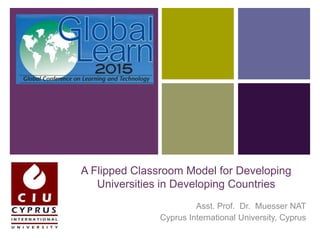GlobalLearn2015Presentation
- 1. + A Flipped Classroom Model for Developing Universities in Developing Countries Asst. Prof. Dr. Muesser NAT Cyprus International University, Cyprus
- 2. + Contents ’ü« Aim of the Study ’ü« Introduction ’ü« Blended/Hybrid Learning and Flipped/Inverted Classrooms ’ü« Active Learning ’ü« Issues on Blended Learning ’ü« A Flipped Classroom Approach ’ü« Challenges ’ü« Conclusion
- 3. + Aim of the Study Create a flipped classroom model by integrating lectures, tutorials and online learning offerings to facilitate active learning and enhance student engagement in large lecture-based classes.
- 4. + Introduction ’ü« Acquiring knowledge became location- and time- independent, and role of instructors and students has changed with the technology ’ü« Active learning increases student experiences and outcomes ’ü« Students use technologies in and out of the classroom, therefore supporting active learning with internet technologies should not be a big challenge ’ü« In North Cyprus, especially first year students attend lectures in large classes ’ü« Blended learning= best of classroom instruction + best of online delivery + using time in physical classrooms for peer-to-peer collaboration and teacher-student interaction.
- 5. + Blended/Hybrid Learning and Flipped/Inverted Classrooms According to Margulieux et al. (2014) ’ü« Blended and Hybrid terms used in the same concept ’ü« Hybrid courses consistently describe instructional location, blended courses consistently describe delivery medium ’ü« Flipped and Inverted used in the same concept ’ü« Flipped and inverted courses consistently describe institutional location and instruction type.
- 6. + Flipped Classroom Johnson (2012) and Carpenter and Pease (2012) described flipped classroom as; ŌĆ£one model of a blended classroom is the flipped classroom, in which students access the curricular content outside of class and then use class time to discuss, apply, and clarify the content.ŌĆØ
- 7. + Active Learning "anything that involves students in doing things and thinking about the things they are doingŌĆØ ’ü« Students fail less and get higher grades when instructors use active learning methods in the classroom ’ü« Introducing activity into lectures can significantly improve recall of information ’ü« Applying active learning methods becomes a challenge when the class size is large.
- 8. + Issues on Blended Learning Benefits ’ü« Improves the efficiency of classroom space ’ü« Increases student retention and student engagement ’ü« Reduces on-campus traffic and the need for parking spaces ’ü« Save time and travel which contributes to cost savings Challenges ’ü« Requires a degree of self-motivation and independent learning capabilities ’ü« Takes longer to prepare and administer than their traditional courses ’ü« Need for specialists who can advise and assist ’ü« Ethical Issues
- 9. + A Flipped Classroom Approach ŌĆó After the class ŌĆó Anytime/An ywhere ŌĆó In the class ŌĆó Before the class Students study online materials Students participate in discussions and activities Students check their understanding and learning Students communicate online with peers/instructor
- 10. + Challenges ’ü« Increased student responsibility ’ü« Instructors need to reconsider what they teach, how they teach and how they assess learning, and how students are best encouraged to learn ’ü« Financial investment and more facilitators are required ’ü« University must encourage instructors to develop flipped classrooms ’ü« Curriculum review process is required to ensure there is academic and departmental support ’ü« Flipped classroom model should be implemented with caution to not demotivate students for future offerings
- 11. + Conclusion ’ü« Student-centred approach with more engagement and interaction ’ü« Encourages students to learn out of the classroom at anytime and anywhere with their own pace ’ü« More students will be able to take high-demand courses ’ü« Instructors will be aware of who is missing classes and will be able to approach students who may be struggling ’ü« Students develop skills in communication, team building, collaborative problem solving and critical thinking skills. ’ü« Faculty members will be encouraged to think more creatively about teaching and learning ’ü« Systematic focus on transforming the learning experience of students in large enrolment classes
- 12. + Thank youŌĆ”












